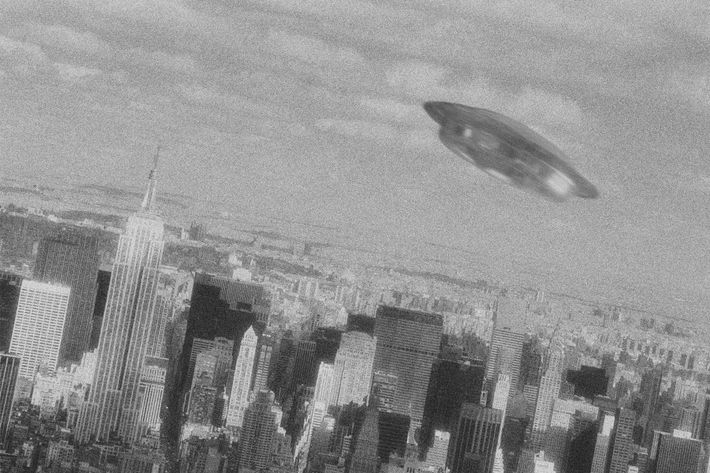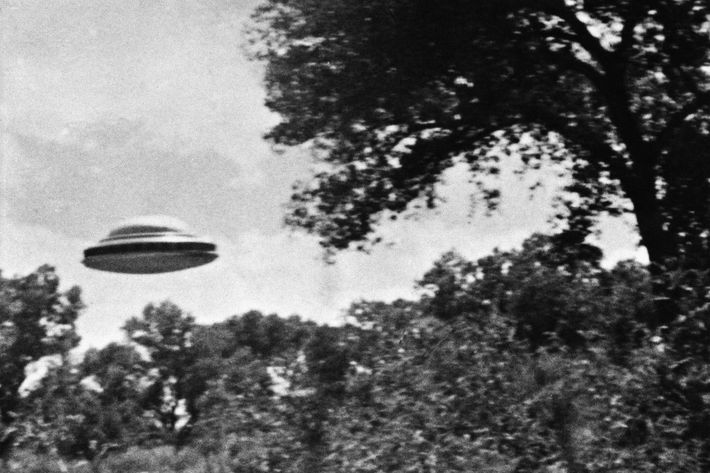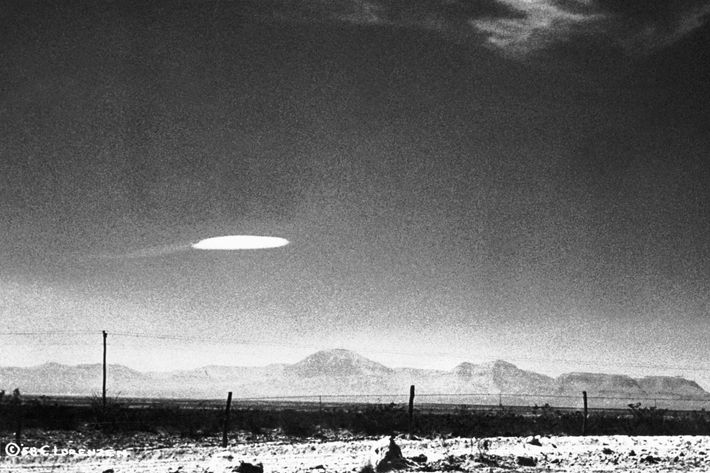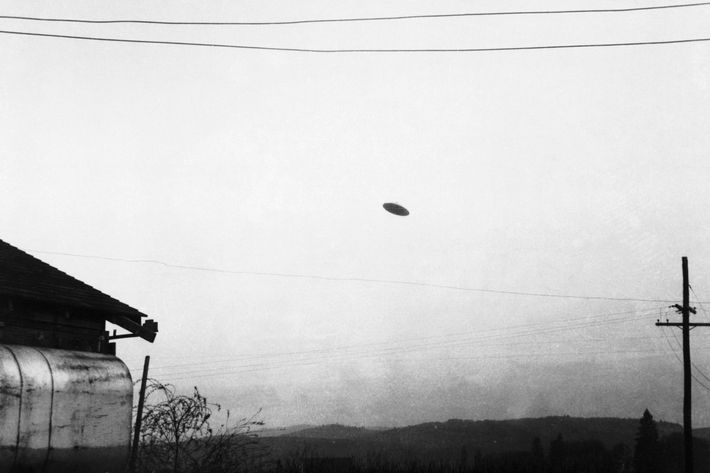
As the news of the day pulsed along the once seemingly unthinkable pathways of the information industry — boots on the ground in Gaza, slide show updates on Mila Kunis’s pregnancy — adherents of an earlier future gathered at the Crowne Plaza Hotel in Cherry Hill, New Jersey. The occasion was the annual conference of the Mutual Unidentified Flying Objects Network, which, in accordance with this year’s theme, “UFOs and the Media,” was focused not on the ephemera of the news cycle but rather on the eternalities of what several in attendance called “the biggest single story in history,” i.e., the existence of extraterrestrial life on Earth and the cover-up of that presence by the United States government, the corporate structure, and their oblivious and/or sold-out lackeys in the mainstream press.
While this year’s symposium attracted a reported 400 people, this was a far cry from the thousands who attended the MUFON conference in the late 1970s, after Close Encounters of the Third Kind introduced extraterrestrials to the mainstream moviegoer. That was at a time when a lot of people actually believed that these mysterious things from the sky represented the biggest single thing in history. Since then, despite the recent astronomical findings of the so-called “Goldilocks zone” that postulates sentient life is possible throughout the galaxy, ufology has apparently lost its grip on the public imagination, and has been demoted to a neo-cult status. For the populace at large space is no longer the place. Not that this mattered to those gathered at Cherry Hill. Used to marginalization, they were resolved to keep watching the skies.

The tone was set by keynote speaker George Knapp, an Emmy-winning reporter for KLAS-TV in Las Vegas, perhaps the best known above-ground correspondent on the ET beat, if you don’t count people like C.J. Jung, who late in life developed a deep interest in what is called “the phenomena.” A debonair raconteur, Knapp spoke of the ridicule he’d received from his MSM colleagues. “I’ll always be the UFO guy,” Knapp related with wry j’accuse, recalling how after doing a story about alleged alien medical procedures, he found himself labeled “the Grand Mullah in the Church of Cosmic Proctology.” The point wasn’t whether UFOs were “real” or a mass hallucination. The news was that people kept seeing them. Yet, according to the gatekeepers of supposed reality, Knapp said, “you, me, and everyone in this room are just a bunch of nuts.”
This was fun, especially when Knapp began talking about Area 51, “the world’s best known top secret base.” In 1989, Knapp broke the story of Robert Lazar, a then 30-year-old scientist who claimed to have worked the remote military facility in the Nevada desert. Lazar’s epic account of how the US armed forces were “reverse engineering” alien technology from crashed and captured flying saucers has become a cornerstone of the late stage UFO narrative. As soon as Lazar opened his mouth, “the meme was on the loose,” Knapp said, resulting in many books, movies, and Area 51-inspired product campaigns accompanied by theme music from the X-Files.

In the context of today’s ever-narrowing attention span, there was only one drawback to this 25-year-old story: It was 25 years old.
Not that the old was out of place in this crowd. MUFON has been around for 45 years and the average age of those who ponied up $239 for the conference was way past that. Many of the presenters, most of them long-established figures on the scene (Stanton Friedman, the 79-year-old widely acknowledged dean of the field, had to cancel owing to a mild heart attack) were equally venerable, as were most of the subjects they discussed. Much talk focused on the genre’s greatest hits: the Betty and Barney Hill abduction account (1961), the Lonnie Zamora/Socorro, New Mexico sighting (1973), the Rendlesham Forest incident in the U.K.(1980), and, of course, Roswell, circa 1947.
As noted, it wasn’t always this way. In another post-A bomb time ufology seemed a wholly appropriate response to a newer, bigger, and far more frightening world. Long before the appearance of Ezekiel’s wheel, people knew something was up there, and now that we’d fired off this nuclear bottle rocket capable of killing millions, the watchers had come in for a closer look. Suddenly palpable millennialism gave impetus to a number of so-called “ufo religions” ranging from the Honorable Elijah Muhammad’s talk of the liberating “mother plane” to ex-sci-fi writer L. Ron Hubbard’s Scientology. It also enabled a breed of typically American loner “independent researchers.” These were the free-thinking, often highly competitive (later highly paranoid) individuals who drove their vehicles into the middle of the desert, looked up into the vast firmament decided that, for better or worse, there had to be another world beyond this one. The fact that the UFO issue represented the first time a large segment of population felt the then-trusted government was withholding the truth from the public only whetted the frisson of the hunt.

It is true that very little beyond a shadow of a doubt forensic proof of alien presence has come to light over the years, but there are a number of subsidiary reasons for the seeming twilight of the UFO moment. With voracious proliferation of vampires, New World Order conspiracies, and the unprecedented rise of evangelical Christianity, the simple flying disc from far, far away has become a quaint, almost nostalgic specter. The saucer may have been the post-war generation’s signifier of the strange, but even versions of the unknown outlive their usefulness. The end of the era may have commenced with William Gibson’s Neuromancer, which located the drama of the unknown inside the claustrophobic cyberspace accessible to the common keyboardist. Instead of the far-flung wonder to the universe, much of what falls under the rubric of contemporary ufology has become deeply interiorized, resigned to the viscous psych-sexual abduction phenomena described and popularized by people like Budd Hopkins, Whitley Strieber, and John Mack. It is a narrative bothers many “hard science” ufologists. “I’m trying to evaluate these sightings,” said Tom Deuley, a no nonsense retired Naval officer, former NSA employee and a leading MUFON investigator for 37 years. “When you bring in crop circles, time-traveling and abductions, these things are hard to quantify.”
It made you wonder where, short of a landing on the White House lawn, ufology could possibly go from here. Case in point was the presentation of Steven Bassett, this year’s winner of the “Excellence in Ufology” award (MUFON executive director Jan Harzan called it “the biggie’). The first registered Washington lobbyist advocating the position that humanity is not alone in the universe, Bassett organized last year’s “Citizen’s Hearing” which enlisted several ex-congress people including former Alaska Governor Mike Gravel to hear testimony on what is now being called “exopolitics” so as to avoid being saddled by the ufology brand. People like astronaut Edgar Mitchell, who walked on the moon, made the case for extraterrestrial visitation. The hope is that the mock hearings would lead to the real thing, which, Bassett was certain would “blow the lid off the Truth Embargo on the alien question that has existed since Roswell.”
After his presentation, I spoke with Bassett, an ardent former business consultant in his middle 60s who described the Disclosure quest as “my life, now.” Victory was inevitable, he thought, saying, “the Catholic Church’s attempt to suppress the Copernican revolution was a doomed enterprise. Now we’re talking about something far more profound than that … when the government tries to contain the reality of the galaxy, that is a task that is Herculean and ultimately can not succeed.” Once the alien presence was acknowledged, humanity would take a meaningful step into “maturity,” Bassett contended.

There was a manic, almost desperate optimism to Bassett’s Disclosure dream that had to be respected. Yet, many conference attendees had their doubts about the program. Bassett had just finished telling me that the Roswell crash probably resulted from the mid-air collision of two alien craft in a thunder storm. This happened, he said, because these were relatively primitive ships. Bassett said he “liked” this explanation. Other people did too. But what happened when the no-doubt heavily redacted “truth” came out and said something different? Wasn’t much of ufology about speculation, peering into the abyss? Besides, several said, what made Bassett so certain the government could end “the Truth Embargo” even if they wanted to? Perhaps the aliens, more powerful and smarter than our lowly bunch, did not want to be Disclosed. Maybe they liked things just the way they are, skulking around the shadowy mythland of the subconscious they’ve inhabited all these eons. Offering a smile, Bassett said. “Well, I guess you’ll just have to ask them about that.”
None of this, however, was a reason to close the books on flying saucers. This would be impossible, since if you happened to have laid eyes on something you sincerely believed to be a UFO, it tends to stick. I will never be free of that cold winter’s night in 1989 when, along with my wife, I saw a saucer-shaped object fly down the East River and soar beneath the Brooklyn Bridge. The way the craft seemed to coquettishly blink its lights as if to say, “even here, I appear, and then disappear” told me, that against all rationality, this particular interface with the ineffable was meant for me.
These are the things you talk about with people like H. Dyke N. Spear at UFO conferences. As George Knapp said, the subject matter does “tend to attract those whose elevator does not got all the way to top,” but you’ll never see Dyke Spear in a tinfoil hat. Past 80, he remained a man of the world, still practicing divorce law in West Hartford, Connecticut. Once he represented the famous featherweight boxing champion Willie Pep. “It was like Willie’s fifth divorce,” Spear related. “He said, relax, this is an easy case. Just give her five rooms of furniture and a fur coat. That’s what they always get.” Asked whether he took any abuse from friends and family about attending UFO conferences, Dyke laughed. “What are they going to tell me, I don’t know what I know?”
Fernando Garces-Soto, a wry, 60-ish Colombian-born music producer from Miami and fellow witness, was taking it more personally. “I’m spending a $1,000 to come to this. That’s a lot of money for the same old stories. This rehash, and more rehash. Probably next year I’ll spend another $1,000. What choice do I have?” Fernando exclaimed, finding the existential humor of the situation. “I’m obsessed,” he sighed. “I’m all messed up.”





























